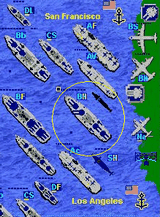USS Ronald
Reagan
USS Abraham
Lincoln Aircraft Carrier
USS
Enterprise Aircraft Carrier
Naval Navy
Tactics ASW AAW
5th US
Fleet
US 6th
Fleet
US 7th
Fleet
USS Ranger
Aircraft Carrier
USS
Forrestal
USN
Cruisers
USN
Destroyers
US Navy
Amphibious
Assault Ships - LHA/LHD/LHA(R)
SSN Attack
Sumbarines 1
USN
Frigates
USN Patrol
Ships
Submarine
BATTLESHIP
GAME
World War 2 Edition
 |
Battleship Game
World War 2
PC Win 10/8/7/ XP Download

|
Battleship Game - WW2
Naval Strategy: the best choice among aircraft carrier games and battleship games.
Missions and Scenarios:
Pearl Harbor Game
Atlantic Game 1943
Sink Cruisers Game
Midway Game
Iwo Jima Game
US Marines Game
Luftwaffe Game Pacific
Torpedo Game Boats
Bismarck Game Pacific
Destroy RAF Game
Okinawa
Us Navy Submarine Game
Fleet Submarines Game
Kamikaze Game
U Boat Game
Singapore Game
Swordfish Hunt
Patrol Boats
Air Supremacy
Alert
Battleships Game
Java
Defense
Fleet Cruisers Game
Atlantic Island
Coral Sea Game
Iron Sea
Mykonos
Imperial Ocean
Long Convoy
Skagerrak
Target Los Angeles
West Pacific Game
Pacific War Game
Leyte Transport
Emperor Hirohito
Normandy Game
South Pacific Game
Destroy USAF Game
Submarine Games
US Navy Game
Free Hunt Doenitz Game
Free Hunt Spruance Game
Free Hunt Halsey Game
Imperial Navy I
Royal Navy Game
Free Hunt Pearl Harbor Games
Midway II
Kriegsmarine I
Brisbane Convoy
Clear West Coast
Fall Of Australia
Battle For Leyte
Conquer Of Japan
HMAS Perth
Road To Okinawa
Orange Ports
Emperor Defense
Prince Of Wales
San Bernardino
Pacific Race
Heavy Duty
Tokio Express
Operation Sidney
Bomber Operation
Conquer Of Italy
Heavy Cruiser Game
Frigate Hunt
Santa Cruz
Lamansh Game
Azores Transport
Norway Convoy
Invasion
Grossadmiral
Norway Ports
Drang Nach Ost
Convoy Pk30
Ciano Defense
Sir John Tovey
Free Hunt Andrews
Germans On Pacific
Silent Hunt
Antigua
Return To Midway
Kriegsmarine Game II
Royal Air Force Game
F. Hunt Lancaster
Jamamoto Game
Free Hunt USN
Free Hunt Japan
Free Hunt RAAF
Free Hunt U Boat Game
Free Hunt Aircraft Carriers Game
Free Hunt Hawaii
Free Hunt Yamato Game
Free Hunt Iwo Jima Game
Free Hunt Pacific Game
Free Hunt Torpedos
Free Hunt Convoy
Free Hunt Germany
Free Hunt Germany II
Free Hunt Italy
Free Hunt Malaya
Free Hunt Subs Game
Free Hunt B-29 Game
Free Hunt USN 1944
Devil Island
Dragoon Carriers
|
Typhoon
Submarine
Also See:
MIG19_Farmer SU35_Sukhoi SU27_Flanker SU24_Fencer MIG21 MIG23_Flogger MIG25_Foxbat MIG29_Fulcrum MIG31_Foxhound Mi24_Hind_Gunship Ka50_Hokum_helicopter KA25 Kamov
Naval Helicopter Kirov
Battlecruiser Kuznetsov
Russian Aircraft Carrier Soviet
Aircraft Carrier Varyag, Russian
navy WW2
The Typhoon-class submarine is a
ballistic missile-carrying, nuclear-powered submarine
(SSBN) deployed by the Soviet Navy in the 1980s. With a
displacement of up to 48,000 tons, the Typhoon is
the largest submarine class in the world ever built.
The name stems from the use of the word
"typhoon" by Leonid Brezhnev in a 1974 speech
while describing a new type of nuclear ballistic missile
submarine. The Typhoon class was developed under Project
941 as the Russian Akula-class (the Russian word for
"Shark", although NATO uses the name Akula
class to designate Russian Project 971 Shchuka-B-class
subs).
The Typhoon-class submarine
is a ballistic missile-carrying, nuclear-powered
submarine (SSBN) deployed by the Soviet Navy in the
1980s. With a displacement of up to 48,000 tons, the
Typhoon is the largest submarine class ever built. The
name stems from the use of the word "typhoon"
by Leonid Brezhnev in a 1974 speech while describing a
new type of nuclear ballistic missile submarine. The
Typhoon class was developed under Project 941 as the
Russian Akula-class (the Russian word for
"Shark", although NATO uses the name Akula
class to designate Russian Project 971 Shchuka-B-class
subs).
Typhoon-class subs feature multiple pressure hulls that
simplify internal design while making the vessel much
wider than a normal submarine (in the main body of the
sub, two Delta-class pressure hulls lie parallel with a
third, smaller pressure hull above them). This also
greatly increases their survivability - even if one
pressure hull is breached, the crew members in the other
are safe and there is less potential for flooding.
| Typhoon Submarine General Characteristics |
| Length |
175 m (574.15 ft) |
| Beam |
23 m (74.5 ft) |
| Draft |
12 m (39.37 ft) |
| Displacement |
Surfaced: 23,200-24,500
tons
Submerged: 33,800-48,000 tons |
| Propulsion |
2 pressurized-water
nuclear reactors
2 propellers
|
| Complement |
163 men |
| Armament: |
4 630 mm torpedo tubes
2 533 mm torpedo
tubes
20 RSM-52 ballistic missiles
|
| Speed |
Surfaced: 12 knots
Submerged: 27 knots
(about 50 km/h)
|
| Maximum Depth |
400 m |
TK 20 Severstal Typhoon-6
* 28 February 1990: Entered 18th division (Zapadnaya
Litsa), NOR.
* 25 August 1996: Successfully launched SLBM
* November 1996: Successfully launched SLBM from North
Pole.
* 24 July 1999: Took part in parade on Navy Day in
Severomorsk, NOR.
* November–December 1999 - distant march.
* 2001: renamed to Severstal.
* June 2001–December 2002: Repairs at Sevmash.
* Commander: A.Bogachev (2001).
834 TK 208 Dmitry Donskoy Typhoon-1
* 9 February 1982: Entered 18th division (Zapadnaya
Litsa), NOR.
* December 1982: Transferred from Severodvinsk to
Zapadnaya Litsa.
* 1983-1984: Tests of D-19 missile complex. Commanders:
A.V.Olkhovikov (1980-1984).
* 3 December 1986: Entered Navy Board of the Winners of
the Socialist Competition.
* 18 January 1987: Entered MoD Board of Glory.
* 20 September 1989–1991: Repairs and refit at
Sevmash to Project 941U. 1991 refit cancelled.
* 1996: Returned to 941U refit.
* 2002: Renamed Dmitry Donskoy.
* 26 June 2002: End of refit.
* 30 June 2002: Start of testing.
* 26 July 2002: Entered sea trials, Re-entered fleet,
without missile system.
* December 2003: Sea trials; refitted to carry a new
Bulava missile system. New missile system expected to be
operational by 2005.
* 9 October 2005: Successfully launched SS-NX-30 Bulava
SLBM from surface.
* 21 December 2005: Successfully launched SS-NX-30 Bulava
SLBM from submerged position on move.
* 7 September 2006: Test launch of the Bulava missile
failed after several minutes in flight due to the
problems in the flight control system. The missile fell
into the sea about a minute after the launch. The sub was
not affected and was returning to Severodvinsk base
submerged. Later reports blamed the engine of the first
stage for the failure.
* 25 October 2006: Test launch of the Bulava-M missile in
the White Sea failed some 200 seconds after liftoff due
to the apparent failure of the flight control system.
* 28 August 2008: Undergone successful testing at the
Sevmash shipyard in Severodvinsk, Arkhangelsk Oblast.
More than 170 men are currently working with the Dmitrii
Donskoy, hundred of them employees at the Sevmash plant
and 70 from other involved companies.
Typhoon
Submarine Unit Listing
|
| Boat |
Chronology |
| # |
number |
Launched |
Comm. |
Stricken |
| 1 |
TK-208
Typhoon 1 |
09/23/1980 |
12/12/1981 |
|
1992 missile
accident,
deactivated for refit
2001 reactivated? |
| 2 |
TK-202
Typhoon 2 |
04/26/1982 |
12/28/1983 |
2000 |
1997-
deactivated for refueling
2000 dismantled |
| 3 |
TK-12
Typhoon 3 |
12/17/1983 |
12/27/1984 |
|
1997-
deactivated for refueling
2000 in reserve |
| 4 |
TK-13
Typhoon 4 |
02/21/1985 |
12/29/1985 |
|
1997-
undergoing overhaul
2000 in reserve |
| 5 |
TK-17
Typhoon 5 |
08/**/1986 |
11/06/1987 |
|
in
service
slated for dismantlement ?? |
| 6 |
TK-20
Typhoon 6 |
07/**/1988 |
09/04/1989 |
|
in service |
| 7 |
TK-210
Typhoon 7 |
|
|
|
Cancelled
under construction |
| CIA / KGB Spy Game. Run your own intelligence
game. Travel around the world and set up
espionage game, trade with state secrets, weapon
systems, spy codes, WMD, hire secretaries,
agents, lawyers and soldiers, establish secret
agent stations, cells and bases and search for
criminals and politicians. Involve in agent game.
Game contains more than 40 missions including
Nuclear Game, Cold War Game, Secret Agent, CIA
Games, USAF, Prime Minister, RAF, Bin Laden,
Sadam, KGB, Operations Iran… |
|
Typhoon Class Russian
submarine Dmitri Donskoi (TK-208)
Name: Dmitri Donskoy
Namesake: Dmitri Donskoy
Laid down: 3 March 1977
Launched: 23 September 1980
Commissioned: 12 December 1981
General characteristics
Class & type: Typhoon-class submarine
Propulsion: 2 ? OK-650 reactors
Armament: 20 ? Bulava SLBMs
4 ? 533 mm (21 in) torpedo tubes
2 ? 650 mm (26 in) torpedo tubes
Typhoon RFS Dmitri Donskoy (TK-208) is a Russian Navy
nuclear ballistic missile submarine, designated Project
941 Akula class (NATO reporting name Typhoon).
TK-208 was the lead vessel of the Soviet third
generation Project 941 Akula class (NATO reporting name
Typhoon) of ballistic missile submarines. She was laid
down at the Severodvinsk shipyards in 1977 and launched
in 1980. At 175 metres in length, she became the world's
largest submarine, a record which she still holds along
with her five sister ships.
In 1990, she entered the dry dock in Severodvinsk for
upgrades and repairs. Due to both economic and
technological problems, the completion was severely
postponed. In 2000, work on her was intensified.
In June 2002, now serving in the Russian Navy, the TK-208
finally left the Severodvinsk dry dock. After 12 years of
overhaul and modifications, she had now received the name
Dmitry Donskoy, named after the Grand Duke of Moscow. The
twenty launchers for the R-39 missiles she originally
carried were replaced with launchers for the most
advanced submarine-launched ballistic missile to date,
the RSM-56 Bulava. Although she was built as a third
generation submarine, she is now referred to as a fourth
generation submarine due to her extensive modifications.
The first launch of a Bulava missile was carried out by
Typhoon Dmitry Donskoy on 27 September 2005. The vessel
was surfaced and fired the missile from a point in the
White Sea. On 21 December 2005, the new missile system
was tested underwater for the first time. It successfully
hit a target on the Kura Test Range on the Kamchatka
Peninsula.
On 9 December 2009, the Typhoon Dmitry Donskoy launched a
Bulava missile which had a failed third stage and was
visible in Norway making a glowing spiral in the sky.
On 7 October 2010, she launched another Bulava ballistic
missile from the White Sea. Targets at the Kura Test
Range in the Russian Far East were successfully hit.
Typhoon class submarines in fiction
A submarine of the Typhoon class with fictional
modifications, called Red October, is the subject of the
Tom Clancy novel The Hunt for Red October. However, none
of the existing ships actually carried that name.
Typhoon submarines are available as naval units when
playing the Soviet faction in the Command & Conquer:
Red Alert 2 strategy game. A virtually identical unit was
featured in the game Command & Conquer: Red Alert (of
which Red Alert 2 is the sequel), but it wasn't
explicitely labelled as a Typhoon
Text is available under
the terms of the GNU Free Documentation License
|
SSBN Submarine Description
Ballistic missile submarines are larger than any other
type of submarine, in order to accommodate SLBMs such as
the Russian R-29 or the American Trident. Although some
early models had to surface to launch their missiles,
modern vessels typically launch while submerged at keel
depths, usually less than 50 meters (164 feet).
SSBN Submarine Purpose
Ballistic missile submarines differ in purpose from
attack submarines and cruise missile submarines; while
attack submarines specialise in combat with other naval
vessels (including enemy submarines and merchant
shipping), and cruise missile submarines are designed to
attack large warships and tactical targets on land, the
primary mission of the ballistic missile is nuclear
deterrence. Accordingly,
the mission profile of a ballistic missile submarine
concentrates on remaining undetected, rather than
aggressively pursuing other vessels. Ballistic missile
submarines are designed for stealth, to avoid detection
at all costs. They use many sound-reducing design
features, such as anechoic tiles on their hull surfaces,
carefully designed propulsion systems, and machinery
mounted on vibration-damping mounts.
Ballistic missile submarines equipped with nuclear
warheads serve as the third leg of the nuclear triad. The
invisibility and mobility of submarines offer both a
reliable means of deterrence against an attack (by
maintaining the threat of a second strike), and a
surprise first-strike capability.
| |
 |
 |
| Turn-based WW2
naval game, extension to the classic
Submarine game (Battleship game) where
ships/planes/subs can move. Contains plenty of
game missions, game campaigns and 40 ship,
submarine, airplane ana port artillery types,
with combat maps up to 96X96 large. |
| |
| |
 |
 |
Guns Girls
Lawyers Spies is a turn-based PC strategy trade
management game. You'll build your
multinational spy company, destroy competition,
hire employees, spies, and businessman, establish
spy cells, bases and objects.
There is a more than 40 missions with different
game objectives |
| |
 |
| Tycoon Strategy
Game - build your own world business empire as an
arms dealer tycoon. Travel around the world,
trade with more than 400 weapon systems, hire
secretaries, bodyguards, lawyers, fighters and
tanks, establish companies and search for
criminals and hostages. |
| |
SSBN
Submarine Terminology
In US naval slang, ballistic missile submarines are
called "boomers", while in Britain, they are
referred to as "bombers". Many navies use two
crews per boat to maximize patrol time. The U.S. Navy
calls them 'blue' and 'gold' crews; the Royal Navy calls
them 'port' and 'starboard' crews; and the French Navy
uses 'blue' and 'red' designations.
SSBN Submarine Active classes
HMS Vanguard, a Royal Navy Vanguard-class submarine
USS Alabama, a US Navy Ohio-class submarine
* France
o Le Triomphant class
* Russian Federation
o Typhoon class submarine
o Delta III and IV classes
o Borei class submarine
* United States
o Ohio class
* United Kingdom
o Vanguard class
* People's Republic of China
o Type 096
o Type 094
o Type 092
o PRC reportedly still operates a single modified
Golf-class diesel-powered ballistic missile submarine
built in 1966, used for testing new SLBM designs.
|